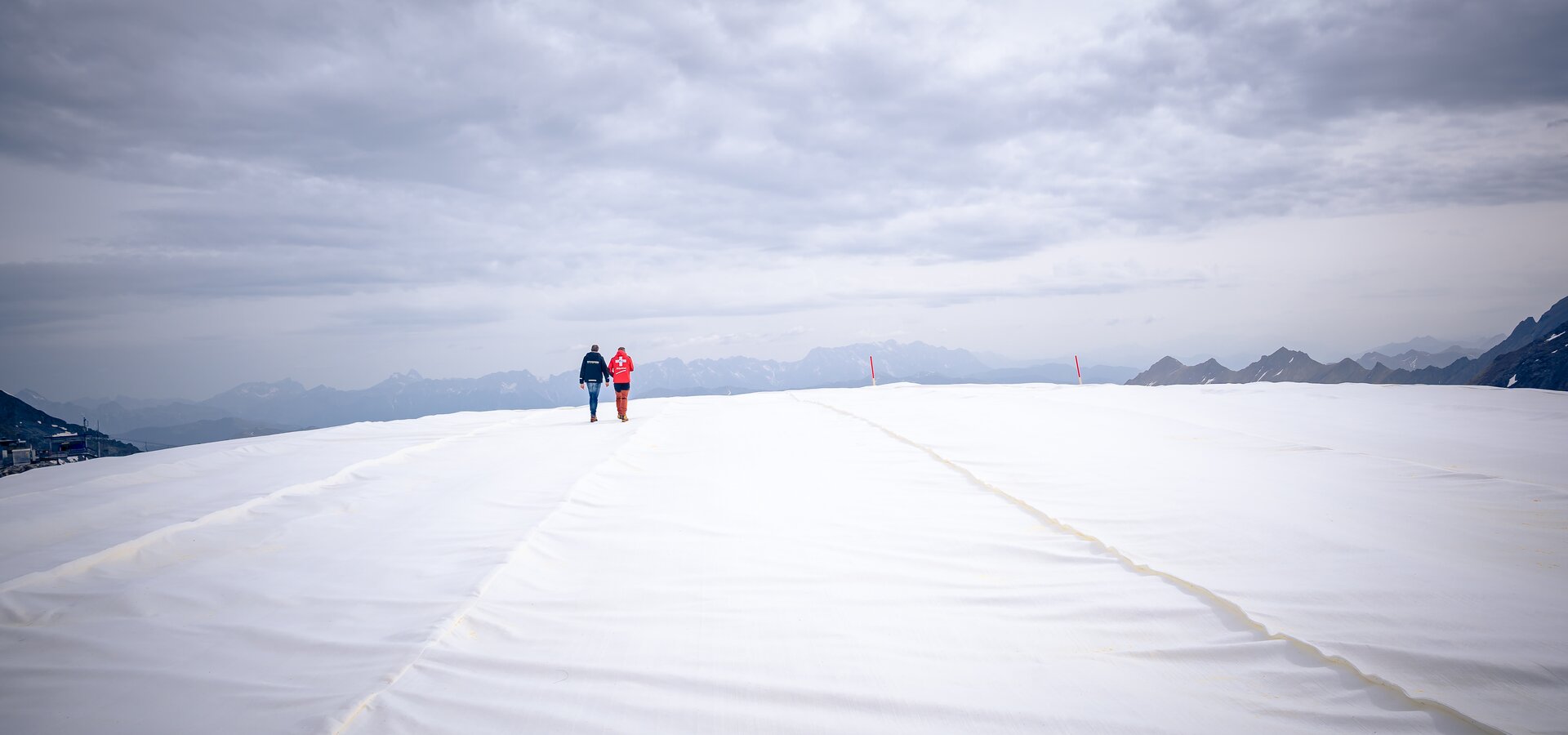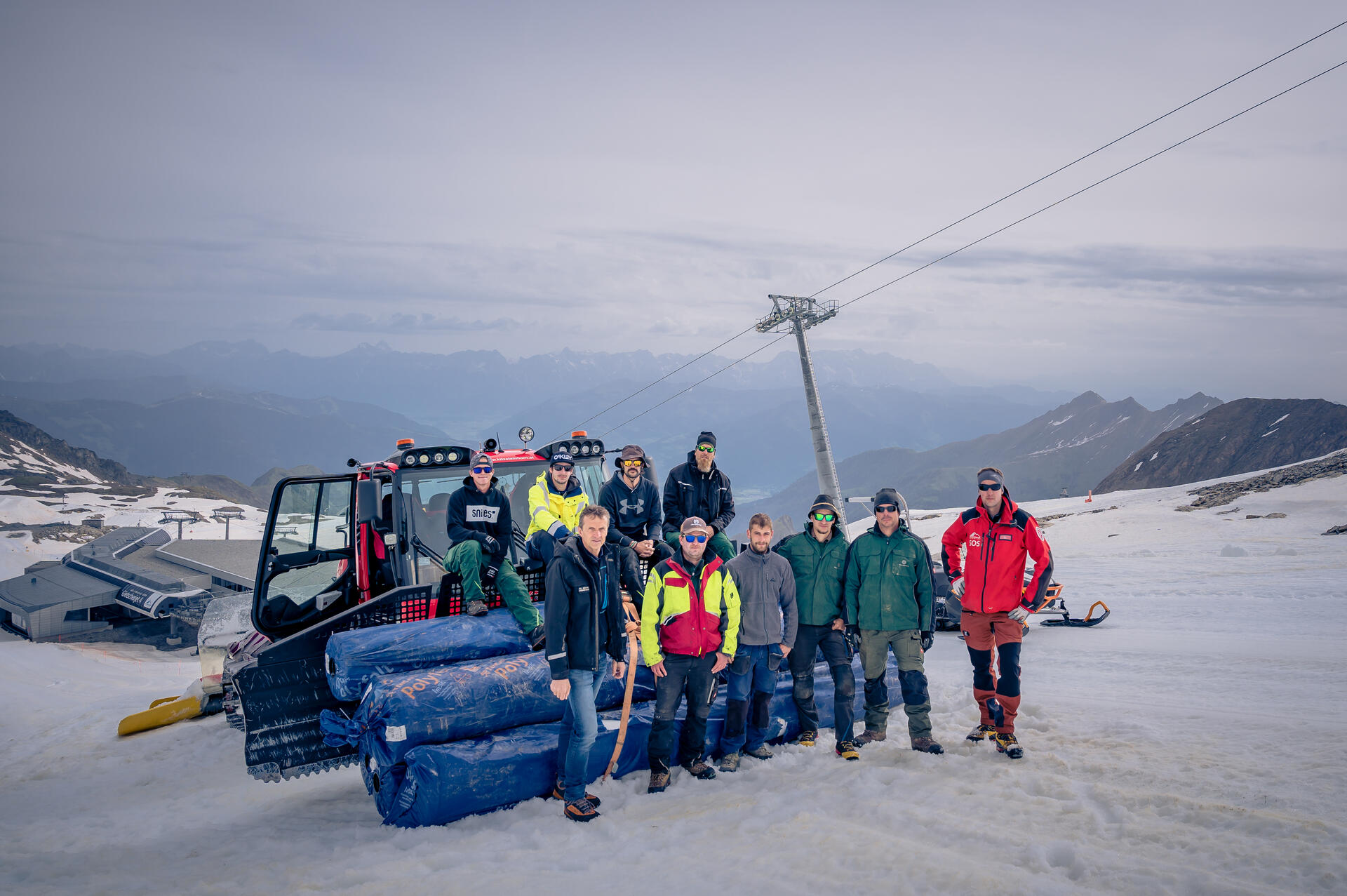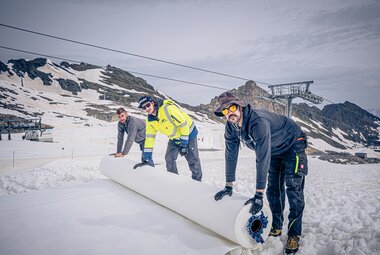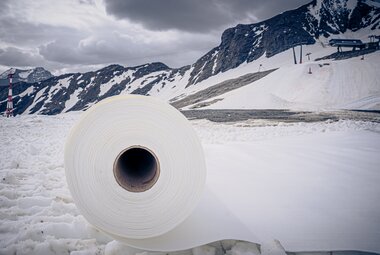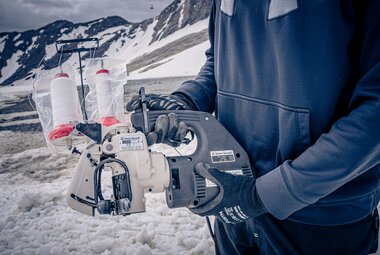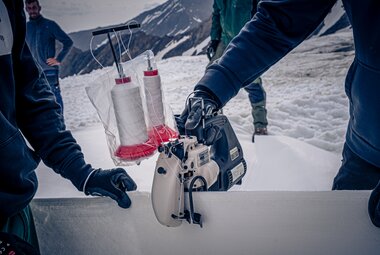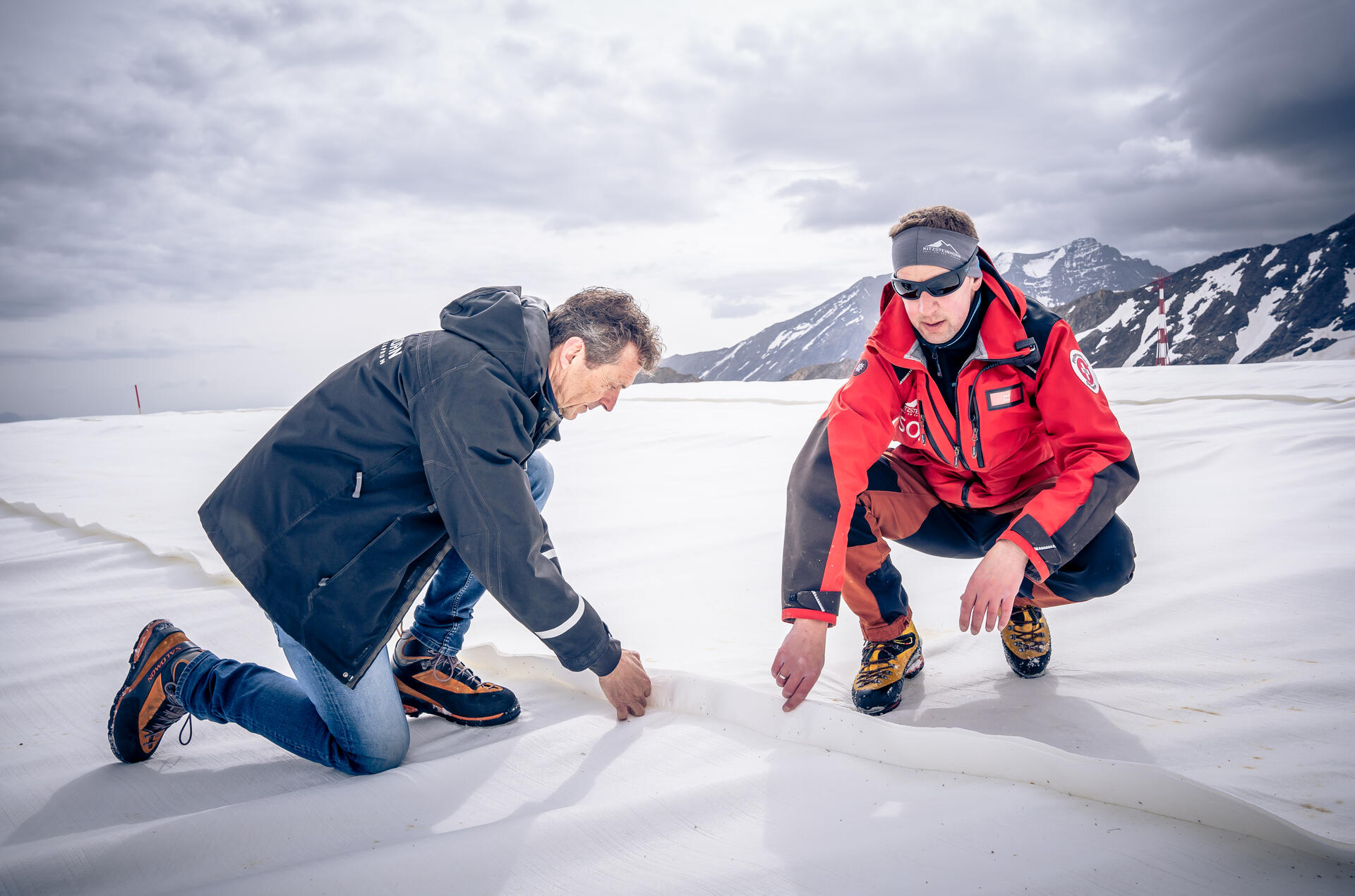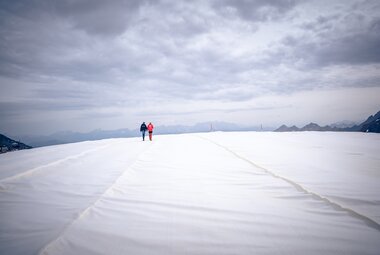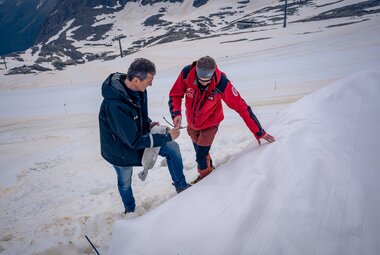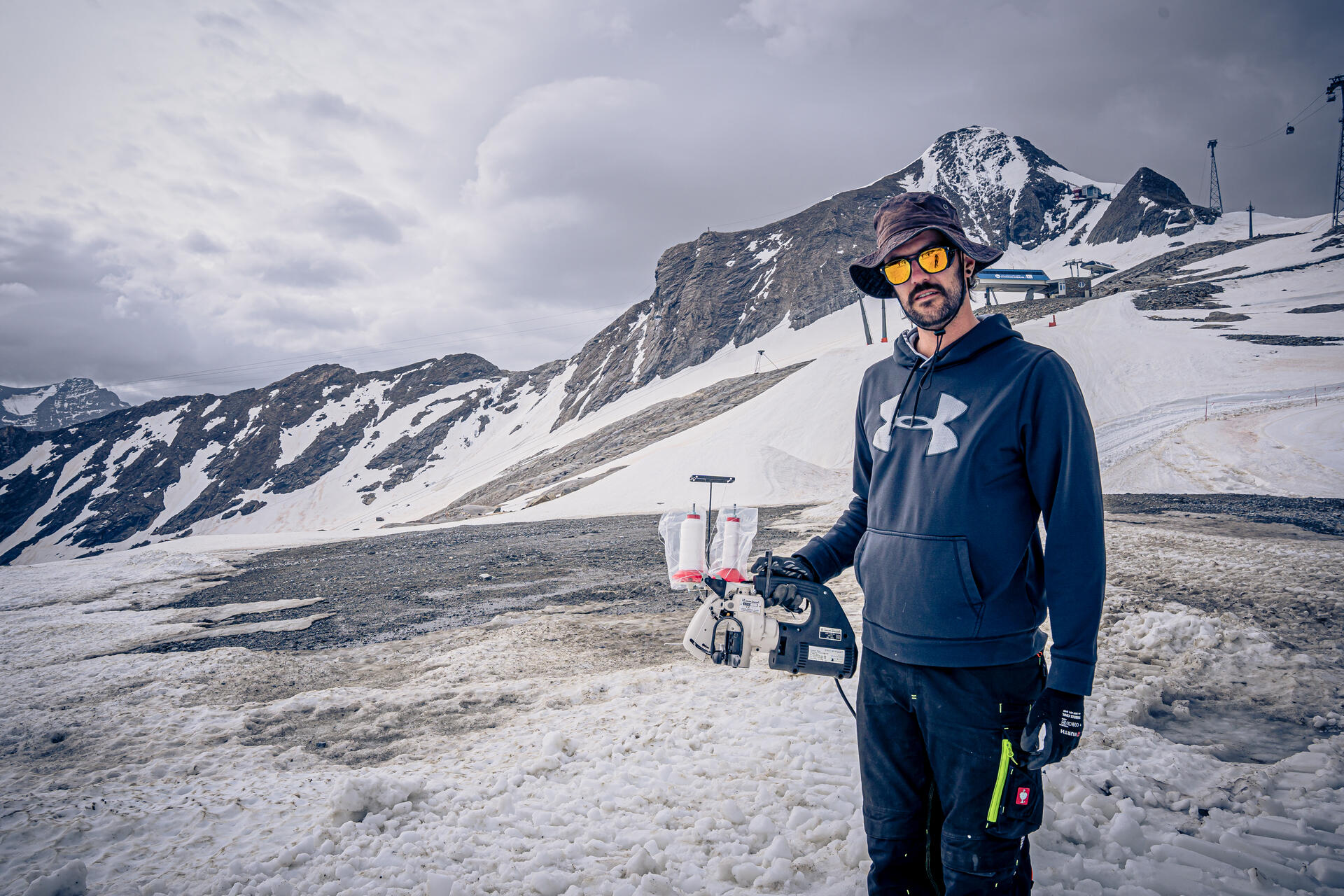Snow reserves on the Kitzsteinhorn give glacier snow a second life and save energy
Storing and preserving rather than melting and remaking – that's the resource-efficient practice of "snow farming" on the Kitzsteinhorn. Large snow reserves not only guarantee snow in early winter but also protect the glacier tongue's ice and save energy.
A total of 200,000 cubic meters of snow are stored over summer in ten snow reserves in the glacier area of the Kitzsteinhorn until winter season starts in early fall. Then, last winter's preserved snow serves as base for around 90,000 square meters of slopes, which corresponds to an area of seven soccer fields.
Protecting the glacier with snow reserves
Snow farming has already been practiced for 15 years on the Kitzsteinhorn. Over this time, the staff has acquired plenty of "snow-how", as Guenther Brennsteiner, one of the company's authorized representatives, tells while ascending the mountain in a snow groomer: "We started our snow reserves under the scientific guidance of GEORESEARCH, a non-profit research institute founded in 2016. That same year, we launched the project "Open Air Lab Kitzsteinhorn" – with the Technical University of Munich and the University of Salzburg as project partners. Together, we have developed our snow reserves, which have proven beneficial to glacier margins."
Covering the ice by the glacier tongue has not only prevented further melting, but we could even record a glacier growth of two and a half meters in some areas.
Covering snow with fleece and a sewing machine
Work on the strategically well-distributed areas of the snow reserves starts in May. Snow groomers push together and compress snow that would normally melt. Head of slopes René Cizek rides to a reserve that's in the making by the valley station of the Schneehasen ski lift on his Ski-Doo; here, other experienced crew members are already waiting.
"We get the best results when the snow has not yet been heated through by the sun and become old snow. Today, our crew will cover the remaining area of the approximately 30,000-square-meter large Schneehasen reserve with fleece, stitch up the sheets with a handheld sewing machine and attach the sandbags."
While ten men lift the fleece rolls up off the snow groomer, Brennsteiner tells: "The fleece has been developed over several years to be specifically used for snow reserves in ski resorts. It's extremely tear-resistant and reflects sunlight. Its incorporated structure allows water to run off in a controlled manner in case of heavy rain."
In order for the fleece to remain in place also in case of a storm, the four-meter-broad sheets are stitched up tightly. Snow-making manager and, in this case, "fleece-cutting master" Stefan Buergler knows exactly how to use the handheld sewing machine. He skillfully threads the strings of the two-spool sewing machine and chainstitches up the overlapping fleece sheets. "In fall, when the fleece is removed from the reserves, the stitch can be taken out with one tug. That way, we can reuse the fleece sheets up to four times", Buergler explains. Hand-filled sandbags with three kilograms each weigh down the fleece sheets so they are not carried away by a storm.
The "snow-how" in snow farming acquired over the years is no company secret: "We're happy to share our knowledge and experience with other ski resorts. International delegations come regularly to learn about our reserves and how to create them. We also work on improving the quality of our fleece", says Brennsteiner. The geotextile's ecological compatibility has been optimized over the years. Alpine ski resorts are committed to using eco-friendly and sustainable materials for snow and ice protection.
Skiing on last winter's snow
Finishing all snow reserves takes the experienced crew around one and a half months. As soon as the last fleece sheet has been stitched, positioned and weighed down, the snow reserves commence their estivation. Over the summer months, René Cizek regularly checks whether fleece and sandbags are still in the right position.
Up to 80% of the stored snow can be preserved over summer, even with high temperatures, and serve as perfect snow-making base in fall, as Brennsteiner explains: "Before winter season starts, we remove the fleece, roll it up and store it away for the next time round. The snow is then distributed evenly over the areas it's needed."
The snow reserves are positioned in strategically well-distributed spots, where snow is needed for an early start of the winter season. The ratio of air temperature to humidity to water temperature does not allow mechanical snow making around this time, which is why last winter's preserved snow is the guarantee for the start of the season. Ideally, there is already some fresh snow when the preserved snow is distributed, for the combination of both makes the perfect base for the whole winter and effectively protects glacier ice.
Protecting the glacier ice
However time and strength consuming creating reserves may be for the team, the sustainability factor and the positive effect they have on glacier ice make the effort worth it. Brennsteiner reports: "Open Air Lab scientists examine glacier loss owing to climate change every year by means of drone imaging. The collected data has shown not only a stop in glacier mass loss in the reserve areas, but even a growth here and there, especially by reserves located higher up the mountain. In the ICE ARENA reserve area, for instance, a growth of 2.5 meters could be recorded over the course of eight years. That motivates us to further deepen our knowledge in snow farming."
| Category | Facts |
|---|---|
| Snow farming competence: | over 15 years |
| Total preserved snow mass: | 200,000 cubic meters in 10 reserves |
| Sufficient for (in fall): | 90,000 square meters of slopes (equals 7 soccer fields) |
| Set up duration: | 1.5 months with a team of 10 people |
| Highest-located reserve: | on 2,900m by the ICE ARENA |
| Glacier growth: | up to 2.5 meters in the reserve area |

